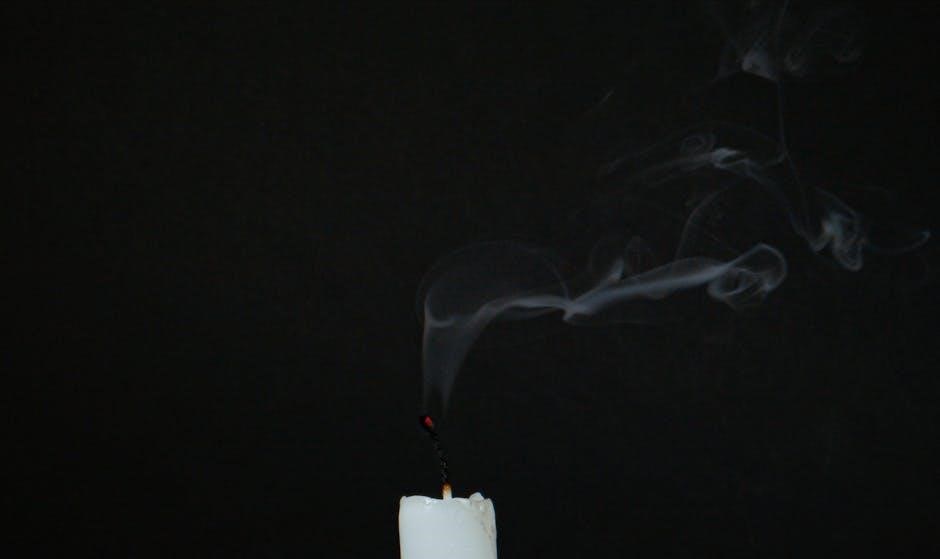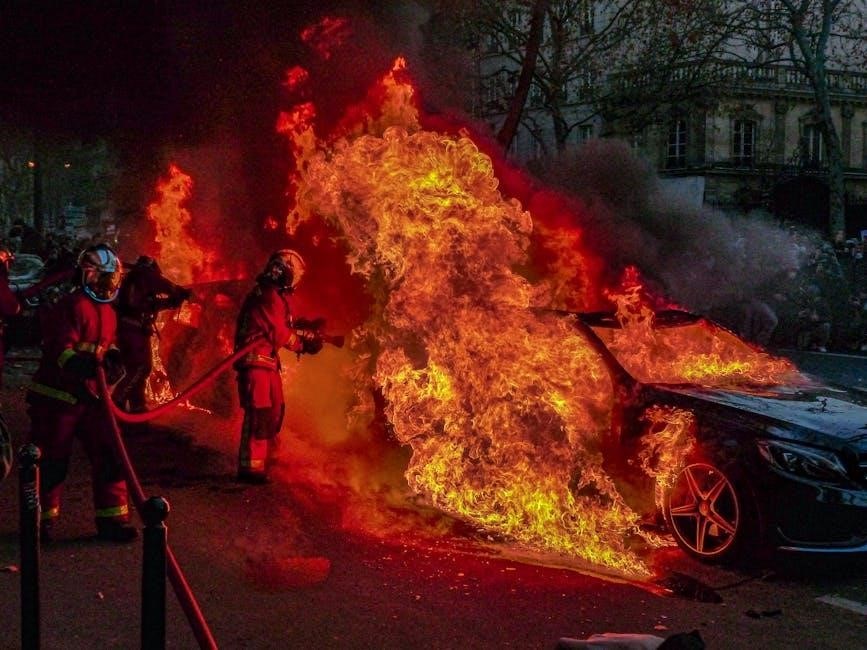Fire extinguishers are essential tools for controlling and extinguishing fires in their early stages. They are classified based on the type of fuel burning, ensuring safe and effective use. Proper training is crucial for operating them correctly, as using the wrong type can worsen a fire. Extinguishers are a critical component of any fire safety strategy, designed to prevent fires from spreading and causing severe damage.

Classification of Fires
Fires are classified based on the type of fuel burning, such as solids, liquids, gases, or special materials. This classification ensures the correct extinguisher is used effectively.
Class A Fires
Class A fires involve ordinary combustible materials such as wood, paper, cloth, plastics, and trash. These fires are fueled by solids that are not metals. Water-based extinguishers are most effective for Class A fires, as they cool the burning material below its ignition temperature. Examples of Class A fires include burning wood in a fireplace, paper waste, or a trash can fire. They are the most common type of fire and typically occur in residential or commercial settings. Proper extinguishment requires removing heat from the combustion process. Other extinguishers, such as foam or dry chemical, may also be used but are less effective than water for Class A fires. Understanding Class A fires is critical for selecting the right extinguisher and ensuring fire safety in everyday environments.
Class B Fires
Class B fires involve flammable liquids or gases, such as gasoline, oil, paint, propane, or butane. These fires are highly dangerous as the fuel can flow, splash, or vaporize, spreading the fire quickly. Dry chemical or foam-based extinguishers are typically used to smother the fire by cutting off oxygen supply and cooling the fuel. Water should never be used on Class B fires, as it can cause the flammable liquid to spread. Examples include gas spills, oil fires in a garage, or a propane tank leak. Proper extinguishment requires careful application to prevent reignition. Class B fires often occur in industrial or automotive settings, making it essential to have the right equipment and training to handle them effectively. Understanding the risks and appropriate extinguishing methods is crucial for ensuring safety in such situations.
Class C Fires
Class C fires involve electrical equipment, such as appliances, wiring, or machinery. These fires are dangerous because they can reignite if the power source is not disconnected. Dry chemical or carbon dioxide extinguishers are typically used, as they do not conduct electricity and can effectively smother the fire. Water should never be used on Class C fires, as it conducts electricity and can cause severe injury or death. Examples of Class C fires include burning electrical panels, faulty wiring, or malfunctioning appliances. Always ensure the power is turned off before attempting to extinguish, if possible. Class C fires require careful handling to prevent electrical shock and reignition. Proper training and the right equipment are essential for safely managing these types of fires in both residential and industrial settings. Understanding the risks and appropriate extinguishing methods is crucial for ensuring safety.

Class D Fires
Class D fires involve combustible metals, such as magnesium, titanium, or sodium. These fires are highly dangerous and require specialized extinguishing agents. Unlike other fire classes, water and foam are ineffective and can even worsen the situation. Dry powder extinguishers, specifically designed for Class D fires, are the most effective solution. These extinguishers smother the fire by removing oxygen and cooling the metal; It is crucial to avoid using water, as it can cause violent reactions with certain metals. Class D fires often occur in industrial settings where metal processing takes place. Proper training and access to the right equipment are essential for safely managing these unique and hazardous fires. Always ensure the fire is fully extinguished to prevent reignition, as smoldering metal can flare up unexpectedly. Class D fires demand immediate and specialized attention to control effectively.
Class K Fires
Class K fires involve cooking oils and greases in commercial cooking appliances, such as deep fryers and grills. These fires are highly hazardous due to the high heat and splatter risk. Wet chemical extinguishers are specifically designed to combat Class K fires by smothering the flames and cooling the surface. They create a barrier that prevents re-ignition, making them ideal for kitchen environments. Unlike water, which can cause oil to splatter and worsen the fire, wet chemical agents are safe and effective. Class K fires often occur in restaurants and food service settings, where proper extinguisher placement and staff training are critical. Using the wrong type of extinguisher can lead to severe consequences, so it is essential to have the correct equipment on hand. These fires require immediate action to prevent damage and ensure safety in the kitchen environment. Class K fires are a unique challenge that demands specialized solutions.
Types of Fire Extinguishers
Fire extinguishers are categorized into water, dry chemical, foam, carbon dioxide, and wet chemical types. Each is designed for specific fire classes, ensuring safe and effective use. Proper selection is vital to control fires efficiently and prevent escalation. These extinguishers cater to various hazards, from ordinary combustibles to electrical and cooking oil fires, making them indispensable in fire safety strategies.
Water-Based Extinguishers
Water-based fire extinguishers are primarily designed to combat Class A fires, which involve ordinary combustible materials like wood, paper, cloth, and plastics. These extinguishers work by cooling the burning material, removing the heat element from the fire triangle. They are typically filled with water or a water-based solution and are effective for fires involving solids. However, water-based extinguishers are unsuitable for electrical fires or those involving flammable liquids, as water can conduct electricity or spread the fire. Proper training is essential to use them safely and effectively. They are widely used in residential and commercial settings due to their simplicity and affordability. Always ensure the extinguisher is rated for the specific fire class to avoid dangerous situations.
Dry Chemical Powder Extinguishers
Dry chemical powder extinguishers are versatile and widely used for combating various types of fires. They are effective against Class A, Class B, and Class C fires, making them a popular choice for general-purpose use. These extinguishers work by releasing a fine powder that creates a barrier between the fuel and oxygen, smothering the fire. The powder also interrupts the chemical reaction in Class C electrical fires, ensuring safe operation. Dry chemical extinguishers are particularly useful in environments like offices, factories, and industrial settings due to their broad applicability. However, they may leave a residue, requiring cleanup after use. Regular maintenance, such as checking pressure gauges and ensuring the powder is free-flowing, is essential for reliability. Their effectiveness across multiple fire classes makes them a critical component of fire safety systems in diverse settings. Always choose the correct type of dry chemical extinguisher for the specific fire hazard present.
Foam-Based Extinguishers
Foam-based extinguishers are specialized tools designed to combat fires involving flammable liquids and solids. They are highly effective against Class A and Class B fires, making them ideal for environments like warehouses, garages, and industrial facilities. The foam works by smothering the fire, starving it of oxygen, and cooling the surface to prevent re-ignition. These extinguishers are particularly useful for fires involving fuels, oils, and paints, as they create a barrier that prevents vapors from igniting. Foam extinguishers are not suitable for electrical fires or Class C fires, as the foam can conduct electricity. Proper training is essential for their use to ensure safety and effectiveness. Regular inspection and maintenance are required to maintain their readiness. Their unique properties make them a valuable addition to fire safety systems in high-risk areas where flammable liquids are present. Always select the appropriate foam extinguisher based on the specific fire hazard.
Carbon Dioxide Extinguishers
Carbon dioxide (CO₂) extinguishers are highly effective for fires involving electrical equipment, flammable liquids, and gases. They work by displacing oxygen, thereby starving the fire of the oxygen needed to burn. CO₂ extinguishers are particularly useful in environments like offices, data centers, and laboratories, where electrical or sensitive equipment is present. They leave no residue, making them ideal for protecting valuable machinery. However, they are less effective on Class A fires (solid materials) and should not be used in outdoor or ventilated spaces, as the CO₂ can dissipate quickly. These extinguishers are also not suitable for deep-seated fires, as they do not penetrate deeply into burning materials. Always ensure the extinguisher is fully charged and used by someone trained in its operation. CO₂ extinguishers are color-coded black for easy identification. They are a critical component of fire safety in areas with high electrical or flammable liquid risks. Regular inspections are essential to maintain their functionality.
Wet Chemical Extinguishers
Wet chemical extinguishers are specifically designed to combat Class K fires, which involve cooking oils and greases in commercial kitchens. They are also effective against Class A fires (solid materials like wood and paper). These extinguishers work by releasing a wet chemical agent that cools the fuel, creating a barrier between the fuel and oxygen, and preventing re-ignition. They are ideal for deep-fat fryers and other cooking equipment. Wet chemical extinguishers are not suitable for Class B or C fires, as they can conduct electricity. They are color-coded yellow for easy identification. Regular maintenance and inspections are essential to ensure their effectiveness. Proper training is recommended for their use, as they require a specific technique to apply the agent effectively. Wet chemical extinguishers are a vital safety tool in environments with high fire risks from cooking appliances. Always follow safety guidelines when operating these devices.
Selection and Placement of Fire Extinguishers
The selection and placement of fire extinguishers are critical for ensuring effective fire safety. Extinguishers must be chosen based on the types of fires likely to occur in a specific area. For example, kitchens require wet chemical extinguishers for cooking oil fires, while garages may need dry chemical extinguishers for flammable liquids. Placement should be strategic, with extinguishers located along escape routes and in areas prone to fire hazards. They must be easily accessible, visible, and no more than 75 feet apart in high-risk zones. Extinguishers should also be mounted at a height where they can be readily reached, typically between 3 to 5 feet off the ground. Proper signage is essential to ensure quick identification. Regular inspections and maintenance are necessary to guarantee functionality. Training individuals on their use is also vital for effective fire response. Compliance with local fire safety regulations is mandatory. By carefully selecting and positioning extinguishers, fire risks can be significantly mitigated, ensuring safety and minimizing potential damage. Always prioritize accessibility and visibility when placing fire extinguishers in any environment. This ensures they are readily available during emergencies, helping to control or extinguish fires before they spread. Proper placement is a key component of a comprehensive fire safety plan and should never be overlooked. It is crucial to assess the specific fire hazards in each area to determine the appropriate number and type of extinguishers needed. This tailored approach ensures that all potential fire risks are adequately addressed, providing a safer environment for everyone.
Maintenance and Inspection Requirements
Regular maintenance and inspections of fire extinguishers are essential to ensure their reliability in emergencies. Monthly inspections should include checking the pressure gauge, verifying accessibility, and ensuring no damage or tampering. Annual inspections must be conducted by trained professionals, focusing on internal conditions and functionality. Extinguishers must be recharged or replaced if discharged, even partially. Hydrostatic testing is required every 12 years to verify cylinder integrity. All maintenance activities should be documented to comply with safety regulations. Extinguishers must be free from obstructions and clearly visible, with proper signage. Any damage or wear, such as dented cylinders or corroded components, necessitates immediate attention. Non-compliance with maintenance standards can lead to legal penalties and compromised fire safety. Always follow manufacturer guidelines and local fire codes to ensure extinguishers remain operational and ready for use. Proper upkeep is critical to saving lives and property during a fire incident. Regular checks help identify issues before they escalate, ensuring extinguishers function optimally when needed most.

Proper Operation of Fire Extinguishers
Proper operation of fire extinguishers is critical to effectively combat fires and ensure safety. The PASS method is a widely recognized technique: Pull the safety pin, Aim the nozzle, Squeeze the handle, and Sweep the extinguishing agent from side to side, covering the base of the fire. Always assess the situation before intervening; extinguishers are most effective on small, contained fires. Using the wrong type of extinguisher for a fire class can worsen the situation. Evacuate the area if the fire is too large or spreading rapidly. Training is essential to understand extinguisher operation and fire behavior. Remember, extinguishers are not a substitute for professional firefighting. Improper use can lead to injury or fire escalation. Always prioritize safety and know when to retreat and call emergency services. Proper technique ensures effective fire control and minimizes risks.

Safety Precautions When Using Fire Extinguishers
Using fire extinguishers requires strict adherence to safety guidelines to avoid accidents and ensure effectiveness. Always assess the fire before intervening; never fight a fire that is too large or spreading rapidly. Evacuate the area and call emergency services if unsure. Ensure proper ventilation when using extinguishers, especially in enclosed spaces, to prevent inhaling harmful fumes. Never use water on electrical or grease fires, as it can cause shocks or explosions. Keep a safe distance from the fire to avoid burns or exposure to extreme heat. Inspect extinguishers regularly to ensure they are fully charged and accessible. Improper use can lead to injury or worsen the fire. Always follow the PASS method for correct operation. Remember, extinguishers are for small, manageable fires only. Prioritize personal safety and the safety of others in all situations. Proper training is essential for safe and effective use. Always know when to retreat and seek professional help;
Fire extinguishers are a vital component of fire safety, offering a first line of defense against small fires. Understanding their types, classifications, and proper use is crucial for effective and safe application. By selecting the right extinguisher for the fire class and following operation guidelines, individuals can prevent minor fires from escalating. Regular maintenance and training ensure readiness and competence. Remember, fire extinguishers are not a substitute for professional firefighting; always prioritize safety and know when to seek help. Their role in protecting lives and property makes them indispensable in every environment. Stay informed and prepared to use extinguishers correctly in emergencies for optimal safety outcomes. Proper use can save lives and reduce damage, emphasizing the importance of education and preparedness in fire safety. Always stay vigilant and proactive in fire prevention and response.

Leave a Reply
You must be logged in to post a comment.